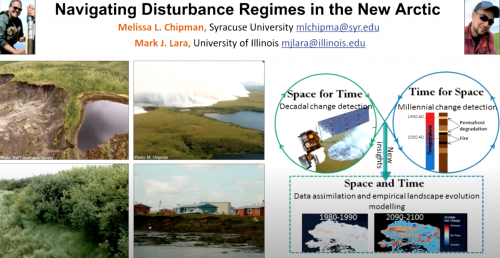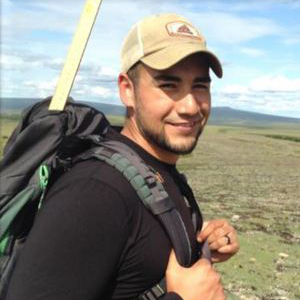Project Abstract
 The Arctic has experienced unprecedented warmth over the past several decades. These areas have also experienced increased disturbances due to wildfires, permafrost degradation, and shrub expansion. Evidence suggests dynamic interactions and feedbacks exist among Arctic disturbance regimes. However, the interdependence of these disturbances makes quantifying their impact challenging. Overcoming this challenge is the first step in improving our capacity to predict future disturbance regimes in the face of climate change. To achieve this goal, researchers will evaluate the vulnerability of Arctic tundra regions in northern Alaska to disturbances over decadal to centennial-time scales. Successful completion of this work will facilitate our ability to predict impacts to local indigenous communities, regional Arctic infrastructure, and global carbon and energy dynamics. Outreach to 20 indigenous Arctic communities will communicate results and develop knowledge to assist these communities adapt to and mitigate impacts.
The Arctic has experienced unprecedented warmth over the past several decades. These areas have also experienced increased disturbances due to wildfires, permafrost degradation, and shrub expansion. Evidence suggests dynamic interactions and feedbacks exist among Arctic disturbance regimes. However, the interdependence of these disturbances makes quantifying their impact challenging. Overcoming this challenge is the first step in improving our capacity to predict future disturbance regimes in the face of climate change. To achieve this goal, researchers will evaluate the vulnerability of Arctic tundra regions in northern Alaska to disturbances over decadal to centennial-time scales. Successful completion of this work will facilitate our ability to predict impacts to local indigenous communities, regional Arctic infrastructure, and global carbon and energy dynamics. Outreach to 20 indigenous Arctic communities will communicate results and develop knowledge to assist these communities adapt to and mitigate impacts.
The objective of this research is to investigate decadal to centennial time-scale interactions between climate, disturbances, and the physical environment across the Alaskan tundra. This will be achieved by examining permafrost degradation, tall shrub expansion, and potential biophysical and biogeochemical feedbacks during disturbances induced by climate change. Historical observations of permafrost degradation and tall shrub expansion will be used to project future landscape evolution. Spatial heterogeneity will be represented by spatially disaggregating the landscape into key state factors that are subdivided into terrain categories and disturbance types. Sophisticated machine learning algorithms will be used to assess decadal patterns of land cover change using high resolution aerial and satellite imagery. These will be used to determine the primary drivers of change to landscape evolution. Paleoecological reconstructions (2,000+ years) of climate, wildfire, permafrost degradation, and shrub expansion will be derived from lake sediment cores and linked with satellite observations to capture patterns of land-cover change spanning decadal to centennial timescales. Together, these results will provide an independent test of the historical drivers of landscape evolution under a range of disturbance regimes. The biogeophysical implications of landscape evolution will be estimated using surveys of vegetation and soil properties, linked with empirical land-cover change models. This project will reconcile several fundamental knowledge gaps that currently limit global climate change projections. In addition, results will help Arctic communities anticipate and adapt to environmental change.
Logistics Summary
The objective of this collaborative project between Lara (1928048, U of Illinois) and Chipman (1927772, Syracuse U) is to evaluate the vulnerability and/or resilience of Arctic tundra in northern Alaska to multiple interacted disturbances spanning decades to millennia. They will work in northern Alaska in 2021, traveling via helicopter to access multiple lake sites. During 2020 research was cancelled due to travel restrictions related to COVID-19. In 2021, a team of 4-5 researchers will either work out of TFS to sample lakes in the vicinity (originally planned for 2020) or will establish a field camp near the Kelly River for approximately a month and use a helicopter to access up to eight separate lakes in the Noatak National Preserve.
Season Field Site
2021 Alaska - Noatak
2021 Alaska - Toolik
Keywords
wildfire, permafrost degradation, shrub expansion, time-series analysis, paleoecology
Project Location
Dates
-Location
Toolik, AK; Noatak River WatershedMembers
Principal Investigator

Principal Investigator

